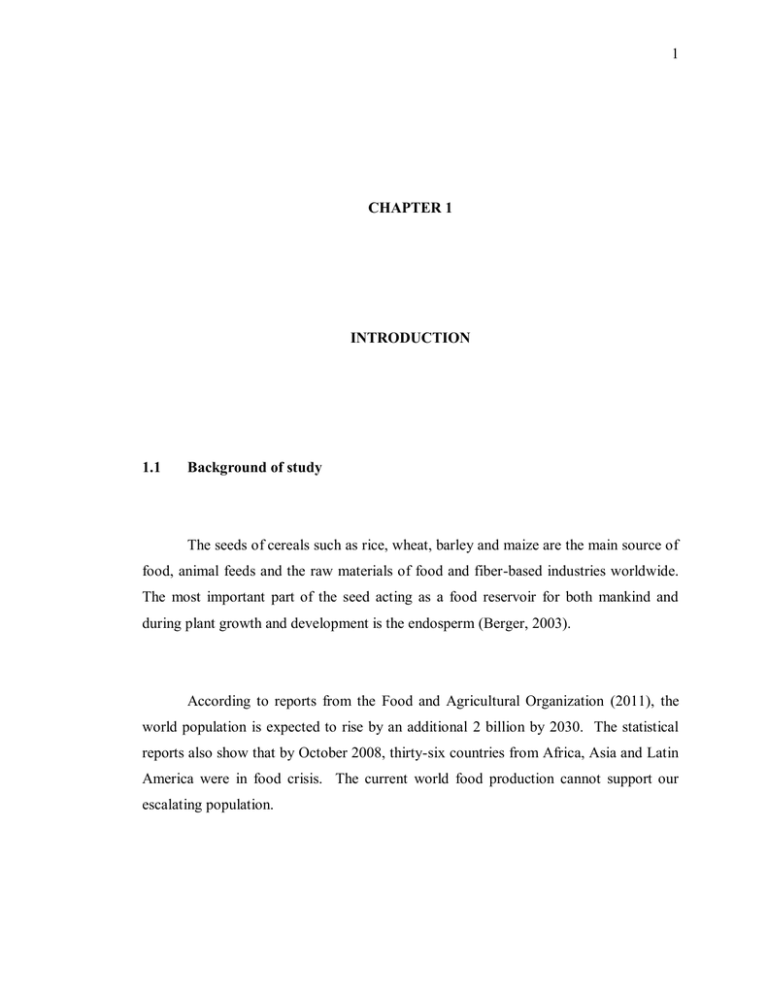1 The seeds of cereals such as rice, wheat, barley and... food, animal feeds and the raw materials of food and...
advertisement

1 CHAPTER 1 INTRODUCTION 1.1 Background of study The seeds of cereals such as rice, wheat, barley and maize are the main source of food, animal feeds and the raw materials of food and fiber-based industries worldwide. The most important part of the seed acting as a food reservoir for both mankind and during plant growth and development is the endosperm (Berger, 2003). According to reports from the Food and Agricultural Organization (2011), the world population is expected to rise by an additional 2 billion by 2030. The statistical reports also show that by October 2008, thirty-six countries from Africa, Asia and Latin America were in food crisis. The current world food production cannot support our escalating population. 2 Rice is a staple food to more than half of the world’s population and therefore stands out as the best candidate for biofortification and biotechnological improvements. This will play a pivotal role in alleviating the world’s nutritional deficiency challenges. The demand for rice by rice consumers is projected to increase by 1.8% annually. The control of powerful endosperm-specific promoters may provide answers to how seed-specific proteins can be increased. A sound understanding of the seed initiation and the control of early endosperm development will be important for increasing cereal crop yield and improving grain quality (Li, 2011). Tissue-specific promoters have the potential to increase recombinant protein stability and deliver targeted gene expression to only specific parts of the plant (Facy, 2009). Different research outcomes have illuminated the importance and role of several endospermspecific promoter regions to engineer transgenic crops with improved endospermspecific biosynthesis (Furtado et al., 2009, Hwang et al., 2002, Kawakatsu and Takaiwa, 2010, Furtado et al., 2008, Sunilkumar et al., 2002, Vickers et al., 2006). Construction of the α-globulin promoter (AsGpro) into the expression vector pCAMBIA1305.2 will allow other researchers to further use this plasmid construct to understand the promoter activity more deeply. In their research, Vickers et al. (2006) showed that α-globulin promoter maintained its endosperm-specific activity in both wheat and barley and its endosperm-specific activity is attributed to the Endosperm Specificity Palindrome (ESP) element (ACATGTCATCATGT) at position -91 while the expression strength was attributed to the GCN4 element. Mutation of GCN4 decreased expression to ~60% while ESP mutation led to loss of endosperm-specific expression. Mutation of both ESP and GCN4 led to total loss of expression. The activity of the α-globulin promoter has not been tested in rice. This new recombinant vector, pCAMGpro bearing the α-globulin promoter and a gene of interest, can be transformed into rice and the expression quantified in relation to other endosperm- 3 specific promoters and the constitutive promoters. If α-globulin endosperm-specific promoter shows significantly higher endosperm-specific expression activity, it can be employed in industrial biosynthesis of food and pharmaceutical proteins. This will alleviate the food crisis facing the globe. 1.2 Problem statement Rice is a staple food to more than half of the world’s population and over 600 million human beings suffer from hunger on a daily basis. The world’s rice production cannot support both the world’s growing population which is expected to rise by an additional 2 billion by 2030 and the rice demand by rice consumers which is projected to increase by 1.8% annually. 1.3 Objectives of study i. To amplify the endosperm-specific α-globulin promoter (AsGpro) from pmCACA:GFP plasmid. ii. To clone the PCR product (AsGpro fragment) into pMR104a and clone the AsGpro:NOS cassette into the expression vector, pCAMBIA1305.2. iii. To analyze the α-globulin promoter sequencing results through bioinformatics and construction of Phylogenetic tree. 4 1.4 Scope of study The scope of this research encompassed amplification and subsequent cloning of the endosperm-specific α-globulin promoter fragment (~823 bp) into the intermediate vector, pMR104a. The AsGpro:NOS cassette (~1,111 bp) will be ligated into the pCAMBIA1305.2 expression vector to produce the recombinant plasmid, pCAMGpro (~12,981 bp) followed by Bioinformatics analysis of the AsGpro fragment. 1.5 Significance of study The endosperm represents approximately 60% of the world’s food supply (Xu et al., 2010) yet only a few strong endosperm-specific promoters have been identified. This research is significant in availing a strong endosperm-specific promoter (Avena sativa α-globulin promoter) that will increase the production of endosperm-specific proteins in transgenic rice that would consequently contribute to improving the nutritional value and quantity of rice which must be increased between 25 - 45% to match-up the growing population of rice consumers (1.8% annually). This will also alleviate the food crisis facing the entire world.


